calsfoundation@cals.org
Peach Industry
Peaches are grown throughout the state of Arkansas with the highest concentrations being in central Arkansas (Pope and Faulkner counties), western Arkansas (Johnson and Franklin counties), southwest Arkansas (Howard and Clark counties), northern Arkansas (Boone, Benton, and Washington counties), and Crowley’s Ridge in eastern Arkansas (Cross and St. Francis counties). Peaches are most successfully produced on light, sandy soils with at least thirty-six inches of soil depth. Orchards are usually placed on locations with raised elevations to avoid or lessen the impact of incidents of low temperature such as frosts.
Peaches were introduced as a crop in Arkansas after the Civil War, as were many other fruits and vegetables, during the New South Diversification movement in agriculture. This movement was brought on by the need to diversify crop varieties to avoid the economic risk of a single crop economy, as evidenced by the overproduction of cotton prior to the war.
The 1879 development of the yellow-fleshed Elberta peach variety in Marshallville, Georgia, by Samuel Rumph made peach growing possible as a viable industry. The Elberta, named for Rumph’s wife, softened more slowly than other varieties. Because of this advantage and the development of refrigerated railroad transportation, peach transport became possible. As railroad spurs spread westward and into the countryside, commercial peach production first reached Arkansas in areas such as Crowley’s Ridge in northeast Arkansas, Clarksville (Johnson County), and Nashville (Howard County).
Elbertas were first planted commercially in Arkansas in the late nineteenth century. As the first trees were planted with grubbing hoes or crowbars, early growers’ methods were primitive and inconsistent. Growers soon formed associations to help one another and to share successful methods and practices in peach farming. They held daylong meetings and invited members of the University of Arkansas Cooperative Extension Service (UACES) to make presentations. Eventually, full-time, university-trained county agents replaced the ad hoc method of improving the orchards. In 1948, UA opened agricultural branch substations in Johnson and Howard counties. The Johnson county substation specialized in fruit, while the Howard County substation focused on peaches.
One of the more prominent peach producers was the Highland Orchard, and many of the orchards in the state have a similar history. In 1904, Bert Johnson, a producer and buyer for the Kansas City Southern railroad, planted one hundred acres of Elbertas on his farm at Highland (Pike County). By 1904, the Highland orchard, operating as the Arkansas Orchard Planting Company and later as Bert Johnson Orchards Inc., was the largest peach orchard in the country with 4,600 acres producing 240,000 bushels of the fruit in a good year.
Cultivation consisted of plowing with mules twice each fall and winter, plowing one direction in the fall and another in the winter. Johnson used a shallow plow near the trees and a deeper plow in the middles. He used spring-tooth harrows for weeds during the growing season and mowed the orchard to facilitate the harvest. For several years, no spray was needed, but in time, a disease called peach scale invaded. At first, the only defense was to pull out the infected trees, but eventually he sprayed a home-mixed insecticide of lime and sulfur on the trees. Next, curculio and brown rot invaded. Dusters applied lead arsenate and lime-sulfur dust to the trees.
At harvest time, workers camped near the orchard or stayed in temporary housing provided by the company. They placed peaches in boxes on mule-drawn wagons, which transported the fruit to one of four large sheds, for each of the four divisions of the orchard. In the sheds, peaches were graded, sized, and packed for rail shipment.
There were two railroads into Highland: the Missouri Pacific and the Prescott and Northwestern. The lines were tied together at the north end of each line so shipments could move in either direction. Storage facilities and icehouses were built at Nashville and Prescott (Nevada County) for shipments. Up to 175 boxcars, each carrying 396 bushel baskets, were shipped from Nashville each day during peak production years.
During the Depression, the orchard went bankrupt. The lien holders broke it into smaller tracts. Glen Wallace of the Missouri Pacific Railroad bought the largest tract and raised peaches into the 1950s. As peach farming became less profitable, the trees were eventually removed, and the land was used for cattle farming.
Other areas shared a similar history. By 1901, Johnson County shipped up to ten boxcar loads of peaches a year. The season lasted only two weeks, typically mid-July to the first of August. From 1912 to 1915, growers produced big crops, but the price per bushel remained low. The peak year for the Nashville area was 1950, when 425 orchards collected more than 400,000 bushels. The year 1925 was also a productive year—250,000 bushels were shipped, and the price hit two dollars a bushel. The peak production year for the state was 1940, when nearly 2.3 million bushels were produced, but the best year for profit may have been 1944, when the federal government set a price ceiling of $4.50 a bushel.
In 1952 and again in 1953, disaster struck Arkansas growers as late freezes followed early warm spells. Two-thirds of the crops were destroyed, and production sank to 150,000 bushels, hurting both producers and brokers. Brokers contracted with growers in California, Florida, and southern Texas—places without late frost. The Arkansas growers lost the market, and the impact was devastating. For Howard County growers, the only option was to pull up the trees and convert the land for other purposes, often pasture for cattle, or to raise chickens. Johnson County fared little better; growers learned to expect a full crop in only three out of five years, while others reported that profits had ceased as far back as 1950.
While Arkansas is currently not a major producer of peaches, the substation in Clarksville continues to be successful in creating new varieties of the fruit. Most recently, professors John N. Clark and James N. Moore were recognized by the 2005 Arkansas General Assembly, along with the UA Horticulture Department and the fruit substation at Clarksville, for the creation of three new varieties of peaches in 2004. The White River, White Rock, and White County varieties are white-fleshed peaches that were developed for growing in the Arkansas climate.
Today, most commercially produced peaches are grown in more temperate climates, such as California, but local producers in Arkansas still grow peaches, selling them at local farmers markets, at roadside stands, and by allowing buyers to pick their own fruit on site.
For additional information:
Zellar, Gary. History of the Bumpers College: Evolution of Education in the Agricultural, Food and Life Sciences in Arkansas. Fayetteville: Arkansas Agricultural Experiment Station, 1999.
James W. Jackson
Texas A&M-Texarkana
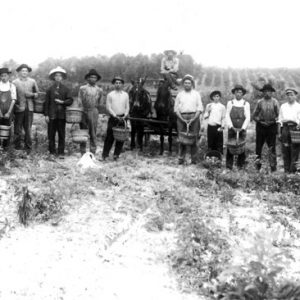 Amity Peach Pickers
Amity Peach Pickers 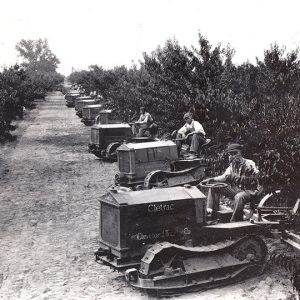 Bert Johnson Orchards
Bert Johnson Orchards 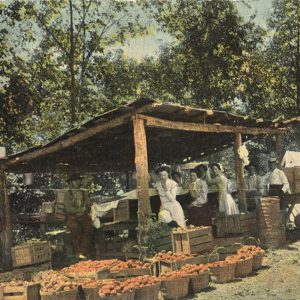 Elberta Peaches
Elberta Peaches 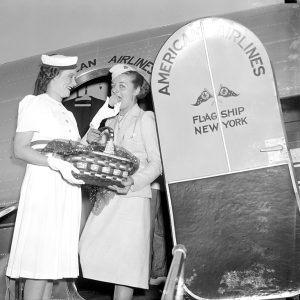 Tolise Gathings
Tolise Gathings 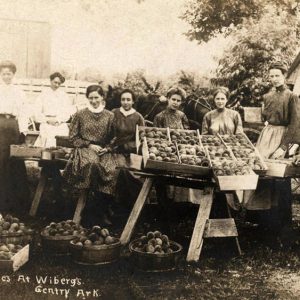 Gentry Peaches
Gentry Peaches  Highland Orchard
Highland Orchard 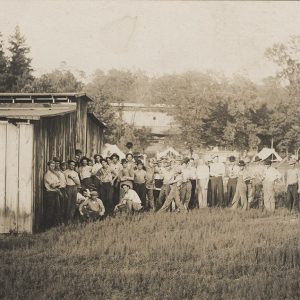 Horatio Peach Harvesters
Horatio Peach Harvesters 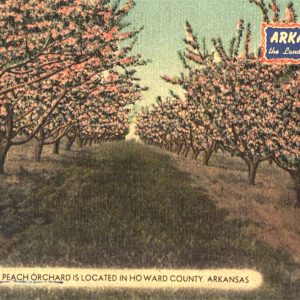 Howard County Peaches
Howard County Peaches 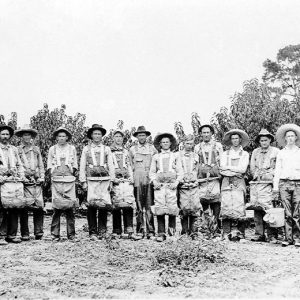 Nashville Peach Pickers
Nashville Peach Pickers 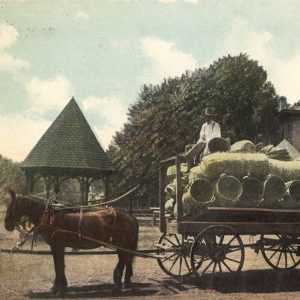 Peach Baskets
Peach Baskets  Peach Festival Float
Peach Festival Float 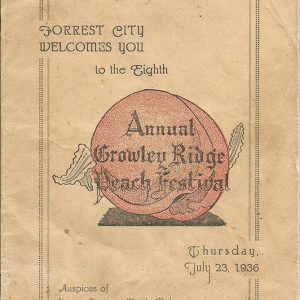 Peach Festival Program
Peach Festival Program 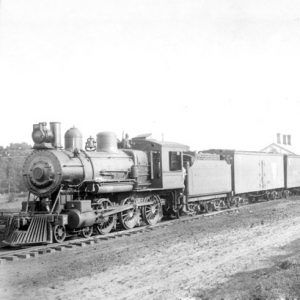 Peach Train
Peach Train 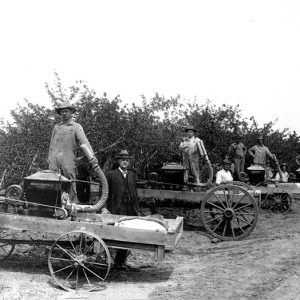 Peach Sprayers
Peach Sprayers  Prescott and Northwestern Elberta Route
Prescott and Northwestern Elberta Route 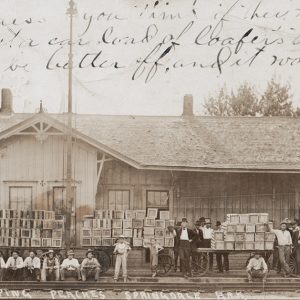 Springdale Peaches
Springdale Peaches 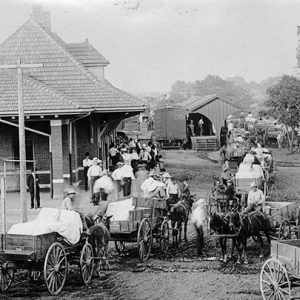 Van Buren Peach Harvesters
Van Buren Peach Harvesters 



We grew peaches for Gerber (baby gold varieties mainly) through the 1980s until the old timers (peach growers) refused to truly integrate IPM measures as newly required by the buyer (Gerber). I was hired by Gerber to be the orchard scout and offer recommendations. When recommended to not spray, sprayers would crank up after I left the farms. Sad reality. Crowley’s Ridge area.